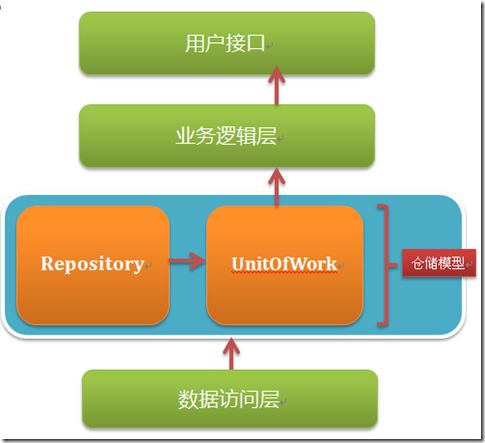TinyFrame升级之七:重构Repository和Unit Of Work
首先,重构的想法来源于以下文章:Correct use of Repository and Unit Of Work patterns in ASP.NET MVC,因为我发现在我的框架中,对UnitOfWork使用了错误的设计方法,同时感谢一下文章:Generically Implementing the Unit of Work & Repository Pattern with Entity Framework in MVC & Simplifying Entity Graphs,我的重构设计参考了它。
下面来说说我的具体重构方式。
在原来的代码中,我的Repository<T>泛型继承自IRepository<T>并且在增删改查代码中做了如下处理:
1: public virtual void Insert(T entity)
2: {
3: try
4: {
5: if (entity == null)
6: throw new ArgumentException("实体类为空");
7: DbSet.Add(entity);
8: context.SaveChanges();
9: }
10: catch (DbEntityValidationException dbex)
11: {
12: var msg = string.Empty;
13: foreach(var validationErrors in dbex.EntityValidationErrors)
14: foreach(var validateionError in validationErrors.ValidationErrors)
15: msg+=string.Format("Property:{0} Error:{1}",validateionError.PropertyName,validateionError.ErrorMessage);
16:
17: var fail = new Exception(msg,dbex);
18: throw fail;
19: }
20: }
最关键的地方是,我添加了“Context.SaveChanges”方法,这就直接导致UnitOfWork的规则失效。UnitOfWork出现的本身是为了提供事务提交支持。这样直接在Repository中提交,直接导致UnitOfWork功能废弃。
还有个地方就是在前台,通过Autofac注册完毕后,我是这么用的:
1: public BookService(IUnitOfWork unitOfWork
2: , IBook bookRepository
3: , IBookType bookTypeRepository
4: , IBookPlace bookPlaceRepository
5: , ICacheManager cacheManager
6: , ILoggerService logger
7: )
8: {
9: this.unitOfWork = unitOfWork;
10: this.bookRepository = bookRepository;
11: this.bookTypeRepository = bookTypeRepository;
12: this.bookPlaceRepository = bookPlaceRepository;
13: this.cacheManager = cacheManager;
14: this.logger = logger;
15: }
16:
17: private readonly IUnitOfWork unitOfWork;
18: private readonly IBook bookRepository;
19: private readonly IBookType bookTypeRepository;
20: private readonly IBookPlace bookPlaceRepository;
21: private readonly ICacheManager cacheManager;
22: private readonly ILoggerService logger;
这样做的话,当以后我们有表删除或者新增的时候,我们不得不维护这样的列表。这完全不符合OO设计原则。
但是如果引入UnitOfWork的话,内部利用Hashtable等实现对Respository的指向,那么在界面我们只要这样写就可以了:
1: public BookService(
2: IUnitOfWork unitOfWork
3: , ICacheManager cacheManager
4: , ILoggerService logger
5: )
6: {
7: this.unitOfWork = unitOfWork;
8: this.cacheManager = cacheManager;
9: this.logger = logger;
10: }
11:
12: private readonly IUnitOfWork unitOfWork;
13: private readonly ICacheManager cacheManager;
14: private readonly ILoggerService logger;
使用的时候,直接这样实例化就行了:
1: var bookPlaceRepository = unitOfWork.Repository<BookPlace>();
这样做完全不用顾虑有新表的添加删除了。代码根本就不用动。
所以,综上两点,UnitOfWork的引入为了解决以下问题:
1.提供全局事务支持。
2.提供对Repository模型的指向。以便于松耦合绑定。
下面是代码重构部分:
IUnitOfWork接口部分:
1: using System;
2: using TinyFrame.Data.DataRepository;
3: using TinyFrame.Data.DomainModel;
4:
5: namespace TinyFrame.Unitofwork
6: {
7: public interface IUnitOfWork
8: {
9: void Commit();
10: IRepository<T> Repository<T>() where T : class;
11:
12: void Dispose(bool disposing);
13: void Dispose();
14: }
15: }
实现部分比较简单,利用Hashtable来保存对Repository的指向:
1: using System;
2: using System.Data.Entity;
3: using TinyFrame.Data.DataRepository;
4: using TinyFrame.Data.DomainModel;
5: using TinyFrame.Data.DataContext;
6: using System.Collections;
7:
8: namespace TinyFrame.Unitofwork
9: {
10: public class UnitOfWork : IUnitOfWork
11: {
12: public UnitOfWork(IDbContext dbContext)
13: {
14: this.dbContext = dbContext;
15: }
16:
17: private readonly IDbContext dbContext;
18: private bool disposed;
19: private Hashtable repositorys;
20:
21: public void Commit()
22: {
23: dbContext.SaveChanges();
24: }
25:
26: public IRepository<T> Repository<T>() where T:class
27: {
28: if (repositorys == null)
29: repositorys = new Hashtable();
30:
31: var type = typeof(T).Name;
32:
33: if (!repositorys.ContainsKey(type))
34: {
35: var repositoryType = typeof(Repository<>);
36: var repositoryInstance = Activator.CreateInstance(repositoryType.MakeGenericType(typeof(T)), dbContext);
37: repositorys.Add(type, repositoryInstance);
38: }
39: return (IRepository<T>)repositorys[type];
40: }
41:
42: #region Dispose method
43: public virtual void Dispose(bool disposing)
44: {
45: if (!disposed)
46: if (disposing)
47: dbContext.Dispose();
48: disposed = true;
49: }
50:
51: public void Dispose()
52: {
53: Dispose(true);
54: GC.SuppressFinalize(this);
55: }
56: #endregion
57: }
58: }
第17行,保持对DbContext的引用,以便于进行提交操作。
第26行,Repository<T>泛型方法,以便于动态返回仓储模型。
需要注意的是,在Repository<T>的实现中,不要再增删改查里面再添加 DbContext.SaveChanges方法,首先是没意义,其次是完全不符合Repository和UnitOfWork的做法。
最后附图一张,表明我对Repository和UnitOfWork的理解:
本章源码下载:
